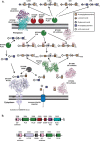Host glycan utilization within the Bacteroidetes Sus-like paradigm
- PMID: 32518945
- PMCID: PMC8252860
- DOI: 10.1093/glycob/cwaa054
Host glycan utilization within the Bacteroidetes Sus-like paradigm
Abstract
The Bacteroidetes are numerically abundant Gram-negative organisms of the distal human gut with a greatly expanded capacity to degrade complex glycans. A subset of these are adept at scavenging host glycans within this environment, including mucin O-linked glycans, N-linked glycoproteins and highly sulfated glycosaminoglycans (GAGs) such as heparin (Hep) and chondroitin sulfate (CS). Several recent biochemical studies have revealed the specific polysaccharide utilization loci (PULs) within the model symbiont Bacteroides thetaiotaomicron for the deconstruction of these host glycans. Here we discuss the Sus-like paradigm that defines glycan uptake by the Bacteroidetes and the salient details of the PULs that target heparin/heparan sulfate (HS) and chondroitin sulfate/dermatan sulfate (DS)/hyaluronic acid (HA), respectively, in B. thetaiotaomicron. The ability of the Bacteroidetes to target highly sulfated host glycans is key to their success in the gut environment but can lead to inflammation in susceptible hosts. Therefore, our continued understanding of the molecular strategies employed by these bacteria to scavenge carbohydrate nutrition is likely to lead to novel ways to alter their metabolism to promote host health.
Keywords: Bacteroides; N-linked glycans; gut microbiota; heparin; mucin.
© The Author(s) 2020. Published by Oxford University Press. All rights reserved. For permissions, please e-mail: journals.permissions@oup.com.
Figures


References
-
- Berteau O, Guillot A, Benjdia A, Rabot S. 2006. A new type of bacterial sulfatase reveals a novel maturation pathway in prokaryotes. J Biol Chem. 281:22464–22470. - PubMed
Publication types
MeSH terms
Substances
Grants and funding
LinkOut - more resources
Full Text Sources
Other Literature Sources

